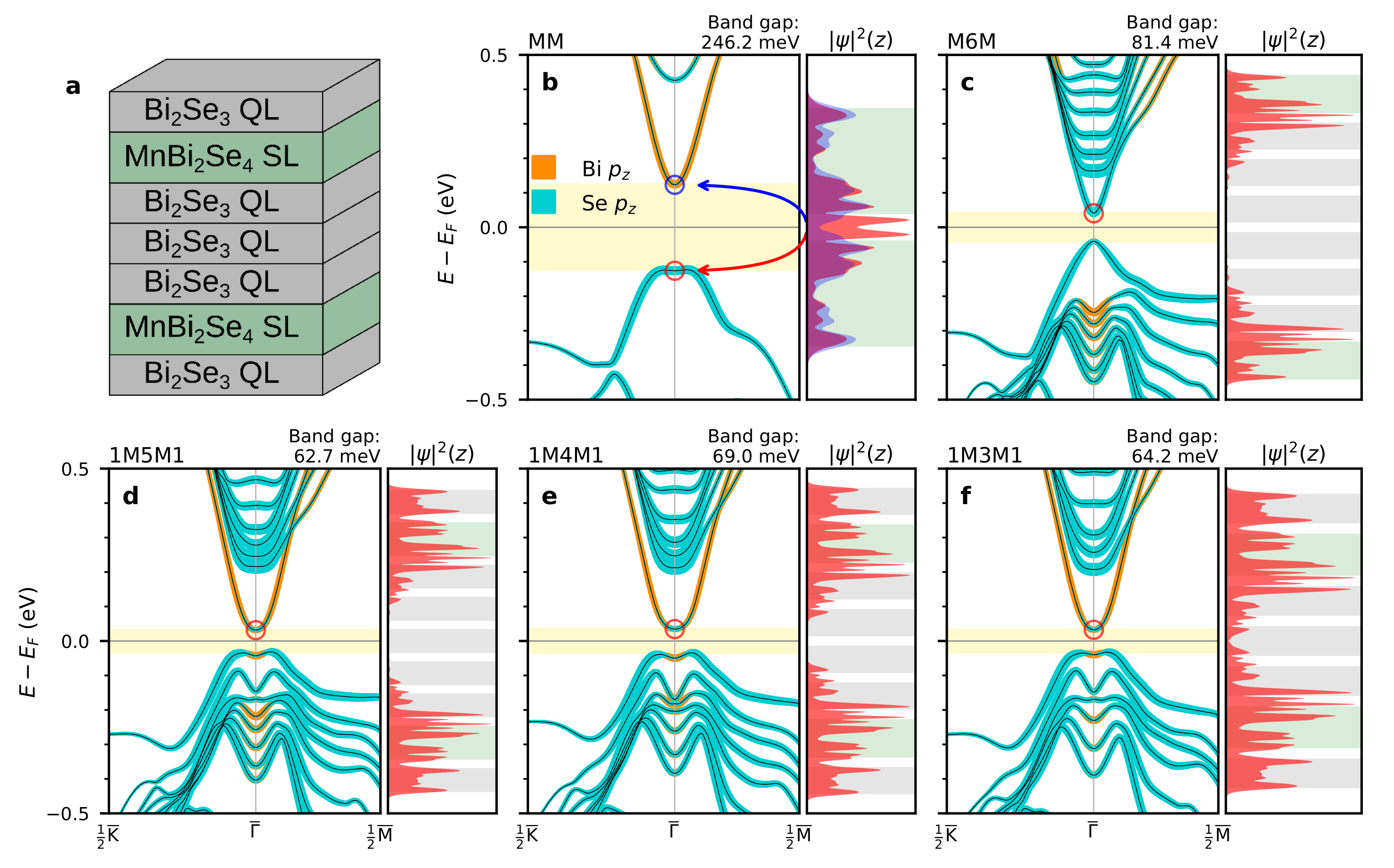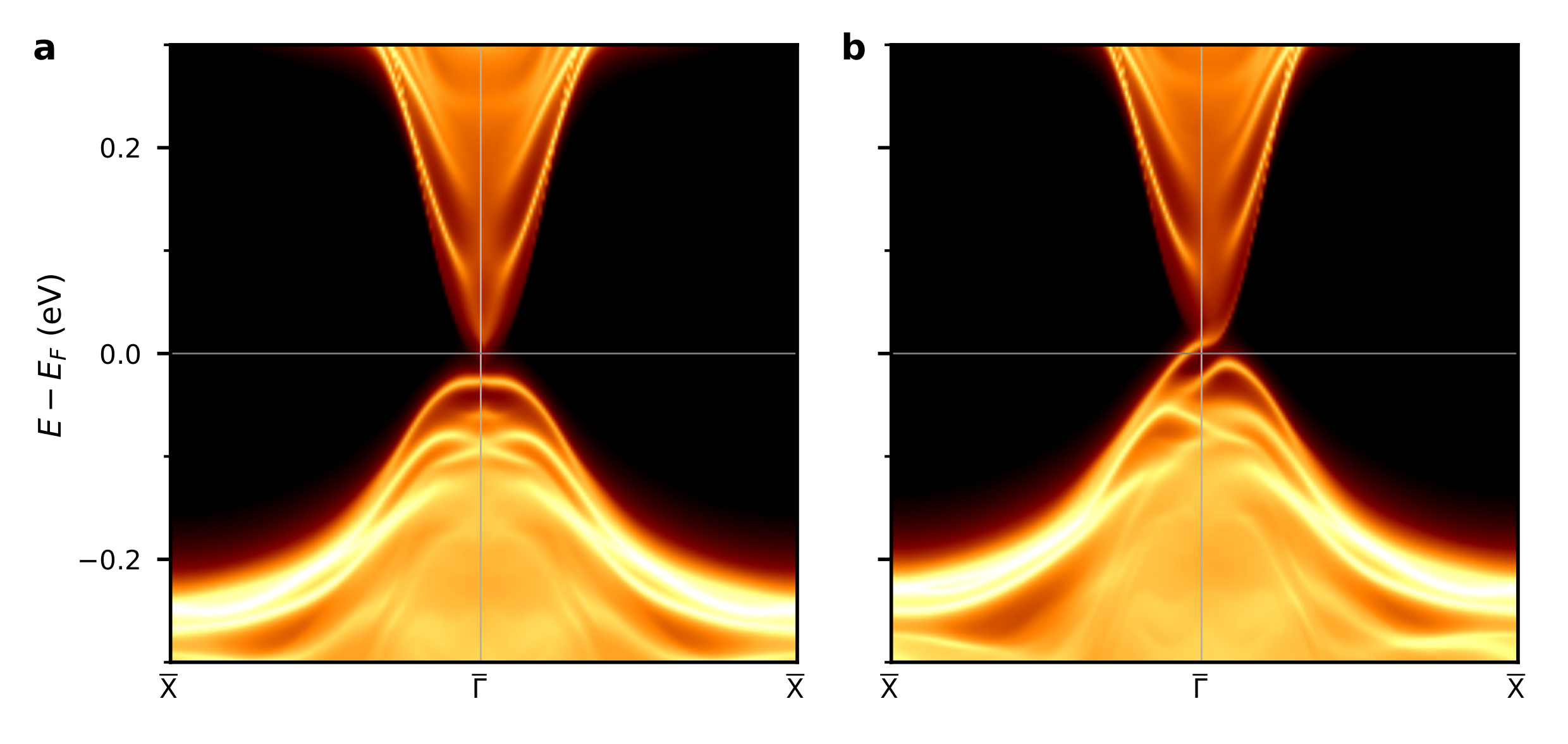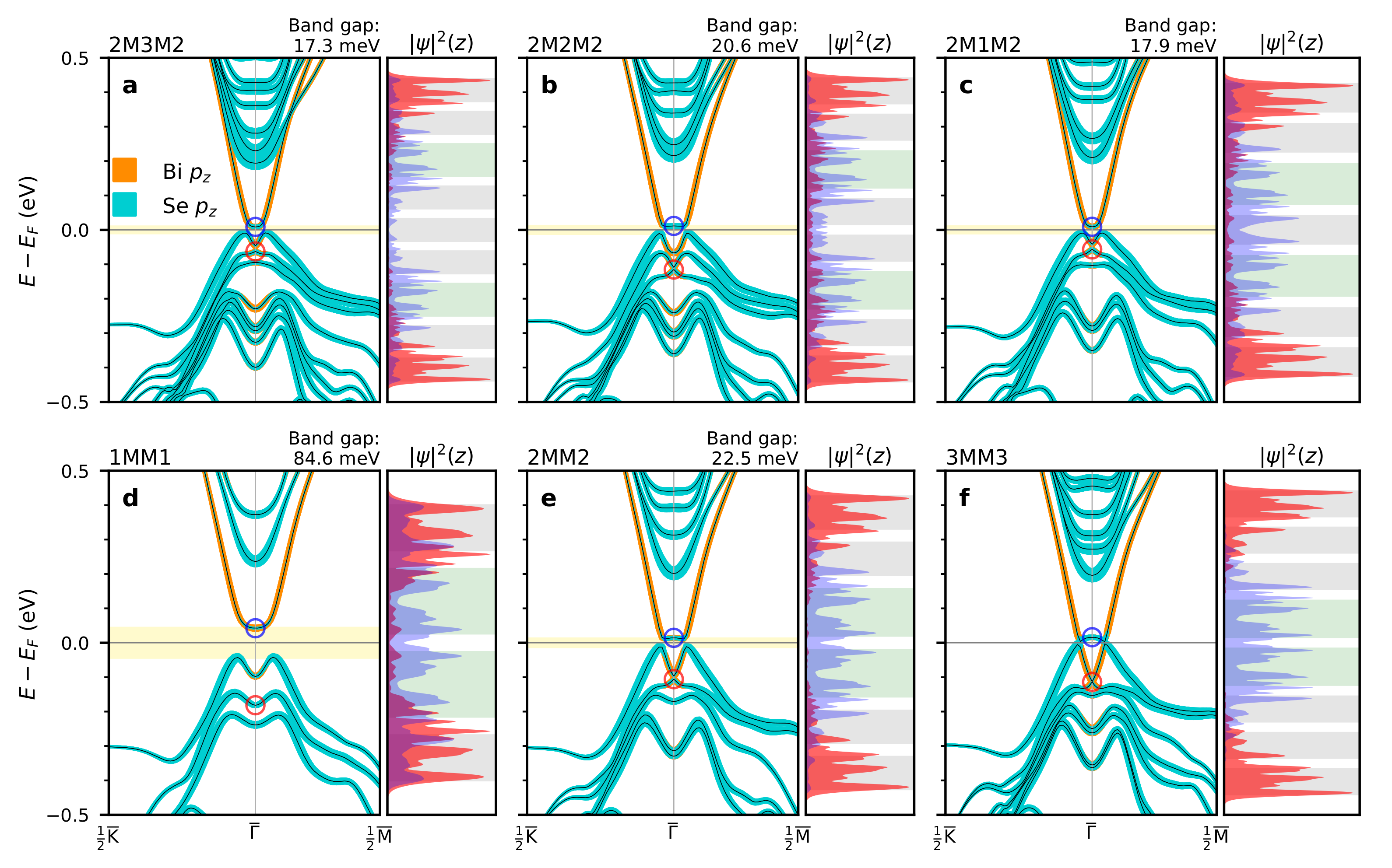MnBi2Se4-Based Magnetic Modulated Heterostructures
Abstract
:1. Introduction
2. Materials and Methods
3. Results
4. Summary and Conclusions
Author Contributions
Funding
Acknowledgments
Conflicts of Interest
References
- Haldane, F.D.M. Model for a Quantum Hall Effect without Landau Levels: Condensed-Matter Realization of the “Parity Anomaly”. Phys. Rev. Lett. 1988, 61, 2015–2018. [Google Scholar] [CrossRef] [PubMed]
- Chang, C.Z.; Zhang, J.; Feng, X.; Shen, J.; Zhang, Z.; Guo, M.; Li, K.; Ou, Y.; Wei, P.; Wang, L.L.; et al. Experimental Observation of the Quantum Anomalous Hall Effect in a Magnetic Topological Insulator. Science 2013, 340, 167–170. [Google Scholar] [CrossRef] [Green Version]
- Checkelsky, J.G.; Yoshimi, R.; Tsukazaki, A.; Takahashi, K.S.; Kozuka, Y.; Falson, J.; Kawasaki, M.; Tokura, Y. Trajectory of the anomalous Hall effect towards the quantized state in a ferromagnetic topological insulator. Nat. Phys. 2014, 10, 731–736. [Google Scholar] [CrossRef] [Green Version]
- Kou, X.; Guo, S.T.; Fan, Y.; Pan, L.; Lang, M.; Jiang, Y.; Shao, Q.; Nie, T.; Murata, K.; Tang, J.; et al. Scale-Invariant Quantum Anomalous Hall Effect in Magnetic Topological Insulators beyond the Two-Dimensional Limit. Phys. Rev. Lett. 2014, 113, 137201. [Google Scholar] [CrossRef]
- Kou, X.; Pan, L.; Wang, J.; Fan, Y.; Choi, E.S.; Lee, W.L.; Nie, T.; Murata, K.; Shao, Q.; Zhang, S.C.; et al. Metal-to-insulator switching in quantum anomalous Hall states. Nat. Commun. 2015, 6, 8474. [Google Scholar] [CrossRef] [Green Version]
- Kandala, A.; Richardella, A.; Kempinger, S.; Liu, C.X.; Samarth, N. Giant anisotropic magnetoresistance in a quantum anomalous Hall insulator. Nat. Commun. 2015, 6, 7434. [Google Scholar] [CrossRef] [Green Version]
- Feng, Y.; Feng, X.; Ou, Y.; Wang, J.; Liu, C.; Zhang, L.; Zhao, D.; Jiang, G.; Zhang, S.C.; He, K.; et al. Observation of the Zero Hall Plateau in a Quantum Anomalous Hall Insulator. Phys. Rev. Lett. 2015, 115, 126801. [Google Scholar] [CrossRef] [PubMed]
- Chang, C.Z.; Zhao, W.; Kim, D.Y.; Zhang, H.; Assaf, B.A.; Heiman, D.; Zhang, S.C.; Liu, C.; Chan, M.H.W.; Moodera, J.S. High-precision realization of robust quantum anomalous Hall state in a hard ferromagnetic topological insulator. Nat. Mater. 2015, 14, 473–477. [Google Scholar] [CrossRef] [PubMed] [Green Version]
- Grauer, S.; Schreyeck, S.; Winnerlein, M.; Brunner, K.; Gould, C.; Molenkamp, L.W. Coincidence of superparamagnetism and perfect quantization in the quantum anomalous Hall state. Phys. Rev. B 2015, 92, 201304. [Google Scholar] [CrossRef] [Green Version]
- Mogi, M.; Yoshimi, R.; Tsukazaki, A.; Yasuda, K.; Kozuka, Y.; Takahashi, K.S.; Kawasaki, M.; Tokura, Y. Magnetic modulation doping in topological insulators toward higher-temperature quantum anomalous Hall effect. Appl. Phys. Lett. 2015, 107, 182401. [Google Scholar] [CrossRef] [Green Version]
- Wilczek, F. Two applications of axion electrodynamics. Phys. Rev. Lett. 1987, 58, 1799–1802. [Google Scholar] [CrossRef]
- Qi, X.L.; Hughes, T.L.; Zhang, S.C. Topological field theory of time-reversal invariant insulators. Phys. Rev. B 2008, 78, 195424. [Google Scholar] [CrossRef] [Green Version]
- Morimoto, T.; Furusaki, A.; Nagaosa, N. Topological magnetoelectric effects in thin films of topological insulators. Phys. Rev. B 2015, 92, 085113. [Google Scholar] [CrossRef] [Green Version]
- Wang, J.; Lian, B.; Qi, X.L.; Zhang, S.C. Quantized topological magnetoelectric effect of the zero-plateau quantum anomalous Hall state. Phys. Rev. B 2015, 92, 081107. [Google Scholar] [CrossRef] [Green Version]
- Mogi, M.; Kawamura, M.; Yoshimi, R.; Tsukazaki, A.; Kozuka, Y.; Shirakawa, N.; Takahashi, K.S.; Kawasaki, M.; Tokura, Y. A magnetic heterostructure of topological insulators as a candidate for an axion insulator. Nat. Mater. 2017, 16, 516–521. [Google Scholar] [CrossRef]
- Mogi, M.; Kawamura, M.; Tsukazaki, A.; Yoshimi, R.; Takahashi, K.S.; Kawasaki, M.; Tokura, Y. Tailoring tricolor structure of magnetic topological insulator for robust axion insulator. Sci. Adv. 2017, 3, eaao1669. [Google Scholar] [CrossRef] [Green Version]
- Geim, A.K.; Grigorieva, I.V. Van der Waals heterostructures. Nature 2013, 499, 419–425. [Google Scholar] [CrossRef]
- Novoselov, K.; Mishchenko, A.; Carvalho, A.; Castro Neto, A.H. 2D materials and van der Waals heterostructures. Science 2016, 353, aac9439. [Google Scholar] [CrossRef] [PubMed] [Green Version]
- Bafekry, A.; Stampfl, C.; Faraji, M.; Yagmurcukardes, M.; Fadlallah, M.M.; Jappor, H.R.; Ghergherehchi, M.; Feghhi, S.A.H. A Dirac-semimetal two-dimensional BeN4: Thickness-dependent electronic and optical properties. Appl. Phys. Lett. 2021, 118, 203103. [Google Scholar] [CrossRef]
- Bafekry, A.; Faraji, M.; Karbasizadeh, S.; Sarsari, I.A.; Jappor, H.R.; Ghergherehchi, M.; Gogova, D. Two-dimensional FeTe2 and predicted Janus FeXS (X: Te and Se) monolayers with intrinsic half-metallic character: Tunable electronic and magnetic properties via strain and electric field. Phys. Chem. Chem. Phys. 2021, 23, 24336–24343. [Google Scholar] [CrossRef] [PubMed]
- Liu, J.; Hesjedal, T. Magnetic Topological Insulator Heterostructures: A Review. Adv. Mater. 2021, 2102427. [Google Scholar] [CrossRef]
- Hirahara, T.; Eremeev, S.V.; Shirasawa, T.; Okuyama, Y.; Kubo, T.; Nakanishi, R.; Akiyama, R.; Takayama, A.; Hajiri, T.; Ideta, S.I.; et al. Large-Gap Magnetic Topological Heterostructure Formed by Subsurface Incorporation of a Ferromagnetic Layer. Nano Lett. 2017, 17, 3493–3500. [Google Scholar] [CrossRef] [Green Version]
- Otrokov, M.M.; Menshchikova, T.V.; Vergniory, M.G.; Rusinov, I.P.; Vyazovskaya, A.Y.; Koroteev, Y.M.; Bihlmayer, G.; Ernst, A.; Echenique, P.M.; Arnau, A.; et al. Highly-ordered wide bandgap materials for quantized anomalous Hall and magnetoelectric effects. 2D Mater. 2017, 4, 025082. [Google Scholar] [CrossRef]
- Otrokov, M.M.; Menshchikova, T.V.; Rusinov, I.P.; Vergniory, M.G.; Kuznetsov, V.M.; Chulkov, E.V. Magnetic extension as an efficient method for realizing the quantum anomalous hall state in topological insulators. JETP Lett. 2017, 105, 297–302. [Google Scholar] [CrossRef]
- Petrov, E.K.; Silkin, I.V.; Menshchikova, T.V.; Chulkov, E.V. Cr-Containing Ferromagnetic Film–Topological Insulator Heterostructures as Promising Materials for the Quantum Anomalous Hall Effect. JETP Lett. 2019, 109. [Google Scholar] [CrossRef]
- Otrokov, M.M.; Klimovskikh, I.I.; Bentmann, H.; Estyunin, D.; Zeugner, A.; Aliev, Z.S.; Gaß, S.; Wolter, A.U.B.; Koroleva, A.V.; Shikin, A.M.; et al. Prediction and observation of an antiferromagnetic topological insulator. Nature 2019, 576, 416–422. [Google Scholar] [CrossRef] [PubMed]
- Otrokov, M.M.; Rusinov, I.P.; Blanco-Rey, M.; Hoffmann, M.; Vyazovskaya, A.Y.; Eremeev, S.V.; Ernst, A.; Echenique, P.M.; Arnau, A.; Chulkov, E.V. Unique Thickness-Dependent Properties of the van der Waals Interlayer Antiferromagnet MnBi2Te4 Films. Phys. Rev. Lett. 2019, 122, 107202. [Google Scholar] [CrossRef] [Green Version]
- Li, J.; Li, Y.; Du, S.; Wang, Z.; Gu, B.L.; Zhang, S.C.; He, K.; Duan, W.; Xu, Y. Intrinsic magnetic topological insulators in van der Waals layered MnBi2Te4-family materials. Sci. Adv. 2019, 5, eaaw5685. [Google Scholar] [CrossRef] [PubMed] [Green Version]
- Zhang, D.; Shi, M.; Zhu, T.; Xing, D.; Zhang, H.; Wang, J. Topological Axion States in the Magnetic Insulator MnBi2Te4 with the Quantized Magnetoelectric Effect. Phys. Rev. Lett. 2019, 122, 206401. [Google Scholar] [CrossRef] [Green Version]
- Gong, Y.; Guo, J.; Li, J.; Zhu, K.; Liao, M.; Liu, X.; Zhang, Q.; Gu, L.; Tang, L.; Feng, X.; et al. Experimental Realization of an Intrinsic Magnetic Topological Insulator. Chin. Phys. Lett. 2019, 36, 076801. [Google Scholar] [CrossRef] [Green Version]
- Mong, R.S.K.; Essin, A.M.; Moore, J.E. Antiferromagnetic topological insulators. Phys. Rev. B 2010, 81, 245209. [Google Scholar] [CrossRef] [Green Version]
- Liu, C.; Wang, Y.; Li, H.; Wu, Y.; Li, Y.; Li, J.; He, K.; Xu, Y.; Zhang, J.; Wang, Y. Robust axion insulator and Chern insulator phases in a two-dimensional antiferromagnetic topological insulator. Nat. Mater. 2020, 19, 522–527. [Google Scholar] [CrossRef] [PubMed] [Green Version]
- Deng, Y.; Yu, Y.; Shi, M.Z.; Guo, Z.; Xu, Z.; Wang, J.; Chen, X.H.; Zhang, Y. Quantum anomalous Hall effect in intrinsic magnetic topological insulator MnBi2Te4. Science 2020, 367, 895–900. [Google Scholar] [CrossRef] [PubMed] [Green Version]
- Gao, A.; Liu, Y.F.; Hu, C.; Qiu, J.X.; Tzschaschel, C.; Ghosh, B.; Ho, S.C.; Bérubé, D.; Chen, R.; Sun, H.; et al. Layer Hall effect in a 2D topological axion antiferromagnet. Nature 2021, 595, 521–525. [Google Scholar] [CrossRef]
- Ge, J.; Liu, Y.; Li, J.; Li, H.; Luo, T.; Wu, Y.; Xu, Y.; Wang, J. High-Chern-Number and High-Temperature Quantum Hall Effect without Landau Levels. Natl. Sci. Rev. 2020, 7, 1280–1287. [Google Scholar] [CrossRef] [PubMed]
- Lei, C.; MacDonald, A.H. Gate-tunable quantum anomalous Hall effects in MnBi2Te4 thin films. Phys. Rev. Mater. 2021, 5, L051201. [Google Scholar] [CrossRef]
- Petrov, E.K.; Men’shov, V.N.; Rusinov, I.P.; Hoffmann, M.; Ernst, A.; Otrokov, M.M.; Dugaev, V.K.; Menshchikova, T.V.; Chulkov, E.V. Domain wall induced spin-polarized flat bands in antiferromagnetic topological insulators. Phys. Rev. B 2021, 103, 235142. [Google Scholar] [CrossRef]
- Aliev, Z.S.; Amiraslanov, I.R.; Nasonova, D.I.; Shevelkov, A.V.; Abdullayev, N.A.; Jahangirli, Z.A.; Orujlu, E.N.; Otrokov, M.M.; Mamedov, N.T.; Babanly, M.B.; et al. Novel ternary layered manganese bismuth tellurides of the MnTe-Bi2Te3 system: Synthesis and crystal structure. J. Alloy. Compd. 2019, 789, 443–450. [Google Scholar] [CrossRef]
- Hu, C.; Gordon, K.N.; Liu, P.; Liu, J.; Zhou, X.; Hao, P.; Narayan, D.; Emmanouilidou, E.; Sun, H.; Liu, Y.; et al. A van der Waals antiferromagnetic topological insulator with weak interlayer magnetic coupling. Nat. Commun. 2020, 11, 97. [Google Scholar] [CrossRef] [Green Version]
- Wu, J.; Liu, F.; Sasase, M.; Ienaga, K.; Obata, Y.; Yukawa, R.; Horiba, K.; Kumigashira, H.; Okuma, S.; Inoshita, T.; et al. Natural van der Waals heterostructural single crystals with both magnetic and topological properties. Sci. Adv. 2019, 5, eaax9989. [Google Scholar] [CrossRef] [Green Version]
- Jahangirli, Z.A.; Alizade, E.H.; Aliev, Z.S.; Otrokov, M.M.; Ismayilova, N.A.; Mammadov, S.N.; Amiraslanov, I.R.; Mamedov, N.T.; Orudjev, G.S.; Babanly, M.B.; et al. Electronic structure and dielectric function of Mn-Bi-Te layered compounds. J. Vac. Sci. Technol. B 2019, 37, 062910. [Google Scholar] [CrossRef]
- Yan, J.Q.; Liu, Y.H.; Parker, D.S.; Wu, Y.; Aczel, A.A.; Matsuda, M.; McGuire, M.A.; Sales, B.C. A-type antiferromagnetic order in MnBi4Te7 and MnBi6Te10 single crystals. Phys. Rev. Mater. 2020, 4, 054202. [Google Scholar] [CrossRef]
- Klimovskikh, I.I.; Otrokov, M.M.; Estyunin, D.; Eremeev, S.V.; Filnov, S.O.; Koroleva, A.; Shevchenko, E.; Voroshnin, V.; Rybkin, A.G.; Rusinov, I.P.; et al. Tunable 3D/2D magnetism in the (MnBi2Te4)(Bi2Te3)m topological insulators family. NPJ Quantum Mater. 2020, 5, 54. [Google Scholar] [CrossRef]
- Vidal, R.C.; Zeugner, A.; Facio, J.I.; Ray, R.; Haghighi, M.H.; Wolter, A.U.B.; Corredor Bohorquez, L.T.; Caglieris, F.; Moser, S.; Figgemeier, T.; et al. Topological Electronic Structure and Intrinsic Magnetization in MnBi4Te7: A Bi2Te3 Derivative with a Periodic Mn Sublattice. Phys. Rev. X 2019, 9, 041065. [Google Scholar] [CrossRef] [Green Version]
- Deng, H.; Chen, Z.; Wołoś, A.; Konczykowski, M.; Sobczak, K.; Sitnicka, J.; Fedorchenko, I.V.; Borysiuk, J.; Heider, T.; Pluciński, Ł.; et al. High-temperature quantum anomalous Hall regime in a MnBi2Te4/Bi2Te3 superlattice. Nat. Phys. 2021, 17, 36–42. [Google Scholar] [CrossRef]
- Eremeev, S.V.; Rusinov, I.P.; Koroteev, Y.M.; Vyazovskaya, A.Y.; Hoffmann, M.; Echenique, P.M.; Ernst, A.; Otrokov, M.M.; Chulkov, E.V. Topological Magnetic Materials of the (MnSb2Te4)·(Sb2Te3)n van der Waals Compounds Family. J. Phys. Chem. Lett. 2021, 12, 4268–4277. [Google Scholar] [CrossRef]
- Hagmann, J.A.; Li, X.; Chowdhury, S.; Dong, S.N.; Rouvimov, S.; Pookpanratana, S.J.; Man Yu, K.; Orlova, T.A.; Bolin, T.B.; Segre, C.U.; et al. Molecular beam epitaxy growth and structure of self-assembled Bi2Se3/Bi2MnSe4 multilayer heterostructures. New J. Phys. 2017, 19, 085002. [Google Scholar] [CrossRef]
- Rienks, E.D.L.; Wimmer, S.; Sánchez-Barriga, J.; Caha, O.; Mandal, P.S.; Růžička, J.; Ney, A.; Steiner, H.; Volobuev, V.V.; Groiss, H.; et al. Large magnetic gap at the Dirac point in Bi2Te3/MnBi2Te4 heterostructures. Nature 2019, 576, 423–428. [Google Scholar] [CrossRef] [Green Version]
- Hirahara, T.; Otrokov, M.M.; Sasaki, T.T.; Sumida, K.; Tomohiro, Y.; Kusaka, S.; Okuyama, Y.; Ichinokura, S.; Kobayashi, M.; Takeda, Y.; et al. Fabrication of a novel magnetic topological heterostructure and temperature evolution of its massive Dirac cone. Nat. Commun. 2020, 11, 4821. [Google Scholar] [CrossRef]
- Eremeev, S.V.; Otrokov, M.M.; Chulkov, E.V. Competing rhombohedral and monoclinic crystal structures in MnPn2Ch4 compounds: An ab-initio study. J. Alloy. Compd. 2017, 709, 172–178. [Google Scholar] [CrossRef] [Green Version]
- Blöchl, P.E. Projector Augmented-Wave Method. Phys. Rev. B 1994, 50, 17953. [Google Scholar] [CrossRef] [PubMed] [Green Version]
- Kresse, G.; Hafner, J. Ab Initio Molecular Dynamics for Liquid Metals. Phys. Rev. B 1993, 47, 558–561. [Google Scholar] [CrossRef] [PubMed]
- Kresse, G.; Furthmüller, J. Efficient Iterative Schemes for Ab Initio Total-Energy Calculations Using a Plane-Wave Basis Set. Phys. Rev. B 1996, 54, 11169. [Google Scholar] [CrossRef] [PubMed]
- Kresse, G.; Furthmüller, J. Efficiency of Ab-Initio Total Energy Calculations for Metals and Semiconductors Using a Plane-Wave Basis Set. Comput. Mater. Sci. 1996, 6, 15–50. [Google Scholar] [CrossRef]
- Perdew, J.P.; Burke, K.; Ernzerhof, M. Generalized Gradient Approximation Made Simple. Phys. Rev. Lett. 1996, 77, 3865. [Google Scholar] [CrossRef] [PubMed] [Green Version]
- Koelling, D.; Harmon, B. A Technique for Relativistic Spin-Polarised Calculations. J. Phys. Solid State Phys. 1977, 10, 3107. [Google Scholar] [CrossRef]
- Grimme, S.; Antony, J.; Ehrlich, S.; Krieg, H. A Consistent and Accurate Ab Initio Parametrization of Density Functional Dispersion Correction (DFT-D) for the 94 Elements H-Pu. J. Chem. Phys 2010, 132, 154104. [Google Scholar] [CrossRef] [Green Version]
- Marzari, N.; Vanderbilt, D. Maximally Localized Generalized Wannier Functions for Composite Energy Bands. Phys. Rev. B 1997, 56, 12847. [Google Scholar] [CrossRef] [Green Version]
- Souza, I.; Marzari, N.; Vanderbilt, D. Maximally Localized Wannier Functions for Entangled Energy Bands. Phys. Rev. B 2001, 65, 035109. [Google Scholar] [CrossRef] [Green Version]
- Mostofi, A.; Yates, J.R.; Pizzi, G.; Lee, Y.S.; Souza, I.; Vanderbilt, D.; Marzari, N. An Updated Version of wannier90: A Tool for Obtaining Maximally-Localised Wannier Functions. Comput. Phys. Commun. 2014, 185, 2309–2310. [Google Scholar] [CrossRef] [Green Version]
- Sancho, M.P.L.; Sancho, J.M.L.; Sancho, J.M.L.; Rubio, J. Highly Convergent Schemes for the Calculation of Bulk and Surface Green Functions. J. Phys. F Met. Phys. 1985, 15, 851–858. [Google Scholar] [CrossRef]
- Wu, Q.; Zhang, S.; Song, H.F.; Troyer, M.; Soluyanov, A. WannierTools: An Open-Source Software Package for Novel Topological Materials. Comput. Phys. Commun. 2018, 224, 405–416. [Google Scholar] [CrossRef] [Green Version]
- Anisimov, V.I.; Zaanen, J.; Andersen, O.K. Band Theory and Mott Insulators: Hubbard U Instead of Stoner I. Phys. Rev. B 1991, 44, 943–954. [Google Scholar] [CrossRef] [Green Version]
- Dudarev, S.; Botton, G.; Savrasov, S.; Humphreys, C.; Sutton, A. Electron-Energy-Loss Spectra and the Structural Stability of Nickel Oxide: An LSDA+U Study. Phys. Rev. B 1998, 57, 1505–1509. [Google Scholar] [CrossRef]
- Youn, S. Calculation of the Hubbard U parameters by the solid atom method. J. Magn. 2005, 10, 71–75. [Google Scholar] [CrossRef]
- Cococcioni, M.; de Gironcoli, S. Linear response approach to the calculation of the effective interaction parameters in the LDA+U method. Phys. Rev. B 2005, 71, 035105. [Google Scholar] [CrossRef] [Green Version]
- Soluyanov, A.A.; Vanderbilt, D. Computing topological invariants without inversion symmetry. Phys. Rev. B 2011, 83, 235401. [Google Scholar] [CrossRef] [Green Version]
- Gresch, D.; Autès, G.; Yazyev, O.V.; Troyer, M.; Vanderbilt, D.; Bernevig, B.A.; Soluyanov, A.A. Z2Pack: Numerical implementation of hybrid Wannier centers for identifying topological materials. Phys. Rev. B 2017, 95, 075146. [Google Scholar] [CrossRef] [Green Version]
- Eremeev, S.V.; Koroteev, Y.M.; Chulkov, E.V. Effect of the atomic composition of the surface on the electron surface states in topological insulators . JETP Lett. 2010, 91, 387–391. [Google Scholar] [CrossRef]



Publisher’s Note: MDPI stays neutral with regard to jurisdictional claims in published maps and institutional affiliations. |
© 2022 by the authors. Licensee MDPI, Basel, Switzerland. This article is an open access article distributed under the terms and conditions of the Creative Commons Attribution (CC BY) license (https://creativecommons.org/licenses/by/4.0/).
Share and Cite
Petrov, E.K.; Kuznetsov, V.M.; Eremeev, S.V. MnBi2Se4-Based Magnetic Modulated Heterostructures. Magnetism 2022, 2, 1-9. https://doi.org/10.3390/magnetism2010001
Petrov EK, Kuznetsov VM, Eremeev SV. MnBi2Se4-Based Magnetic Modulated Heterostructures. Magnetism. 2022; 2(1):1-9. https://doi.org/10.3390/magnetism2010001
Chicago/Turabian StylePetrov, Evgeniy K., Vladimir M. Kuznetsov, and Sergey V. Eremeev. 2022. "MnBi2Se4-Based Magnetic Modulated Heterostructures" Magnetism 2, no. 1: 1-9. https://doi.org/10.3390/magnetism2010001
APA StylePetrov, E. K., Kuznetsov, V. M., & Eremeev, S. V. (2022). MnBi2Se4-Based Magnetic Modulated Heterostructures. Magnetism, 2(1), 1-9. https://doi.org/10.3390/magnetism2010001





